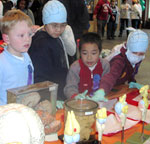| WHAT: |
 |
Great photo opportunity! Third- and fourth-graders learn about the brain at the 2008 Fair. |
Over 130 third and fourth graders from the Penn Alexander School, the Samuel Powel Elementary School, and the Sterck/Delaware School for the Deaf will spend a morning on the Penn campus “judging” hands-on science activities developed by students at Penn, including undergraduate Biological Basis of Behavior program majors and graduate students in neuroscience.
Highlights:
- Brainapalooza: Faculty and students let the judges see and handle all kinds of brains. Very hands-on, very yucky-cool.
- Food for Thought: Ever wonder how your stomach communicates with yourbrain so you know you’re hungry or full? Wonder no longer! Judges takethis journey along the road between stomach and brain and see how it allworks, and why.
- Left Brain/Right Brain What? We use both sides of our brain for something as simple as tying our shoes? Watch as two students cooperate to tie a shoelace while each only uses one free hand.
|
| WHEN: |
Wednesday, April 1, 2009
Prime judging time: 9:30am- 11:00am |
| WHERE: |
Biomedical Research Building Lobby
421 Curie Boulevard
View on Campus Map
|
| WHO: |
The Penn KidsJudge! Fair, a national education program designed to make scientists better communicators and elementary school children better scientists, is sponsored by Penn’s Mahoney Institute for Neurosciences and the Biological Basis of Behavior Program. The Fair is also made possible in part by grants from the National Kids Judge! Partnership, the Dana Alliance for Brain Initiatives, and National Institute on Drug Abuse. |
###
PENN Medicine is a $3.6 billion enterprise dedicated to the related missions of medical education, biomedical research, and excellence in patient care. PENN Medicine consists of the University of Pennsylvania School of Medicine (founded in 1765 as the nation's first medical school) and the University of Pennsylvania Health System.
Penn's School of Medicine is currently ranked #4 in the nation in U.S.News & World Report's survey of top research-oriented medical schools; and, according to most recent data from the National Institutes of Health, received over $379 million in NIH research funds in the 2006 fiscal year. Supporting 1,700 fulltime faculty and 700 students, the School of Medicine is recognized worldwide for its superior education and training of the next generation of physician-scientists and leaders of academic medicine.
The University of Pennsylvania Health System (UPHS) includes its flagship hospital, the Hospital of the University of Pennsylvania, rated one of the nation’s top ten “Honor Roll” hospitals by U.S.News & World Report; Pennsylvania Hospital, the nation's first hospital; and Penn Presbyterian Medical Center. In addition UPHS includes a primary-care provider network; a faculty practice plan; home care, hospice, and nursing home; three multispecialty satellite facilities; as well as the Penn Medicine Rittenhouse campus, which offers comprehensive inpatient rehabilitation facilities and outpatient services in multiple specialties.
Penn Medicine is one of the world’s leading academic medical centers, dedicated to the related missions of medical education, biomedical research, excellence in patient care, and community service. The organization consists of the University of Pennsylvania Health System and Penn’s Raymond and Ruth Perelman School of Medicine, founded in 1765 as the nation’s first medical school.
The Perelman School of Medicine is consistently among the nation's top recipients of funding from the National Institutes of Health, with $550 million awarded in the 2022 fiscal year. Home to a proud history of “firsts” in medicine, Penn Medicine teams have pioneered discoveries and innovations that have shaped modern medicine, including recent breakthroughs such as CAR T cell therapy for cancer and the mRNA technology used in COVID-19 vaccines.
The University of Pennsylvania Health System’s patient care facilities stretch from the Susquehanna River in Pennsylvania to the New Jersey shore. These include the Hospital of the University of Pennsylvania, Penn Presbyterian Medical Center, Chester County Hospital, Lancaster General Health, Penn Medicine Princeton Health, and Pennsylvania Hospital—the nation’s first hospital, founded in 1751. Additional facilities and enterprises include Good Shepherd Penn Partners, Penn Medicine at Home, Lancaster Behavioral Health Hospital, and Princeton House Behavioral Health, among others.
Penn Medicine is an $11.1 billion enterprise powered by more than 49,000 talented faculty and staff.